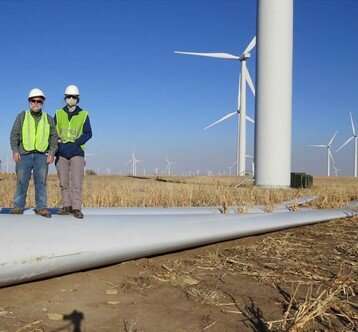
By SHAWNA BETHELL
Kansas Reflector
I remember the first time I saw a wind turbine.
I had just come driving out of a canyon in Utah and into an open valley. There stood three massive, languidly rotating harbingers of the future. Those were the early days of wind energy, and I found the mechanical structures not only fascinating but also artistic in their clean, white, elegant forms. Today, on our own western plains, turbines have become a ubiquitous part of the landscape, and in spite of controversies such as bird mortality and sound pollution, I’m proud of Kansas for being a leader in clean energy.
However, with those plentiful turbines comes the problem of what to do with hundreds of thousands of blades when they come out of commission. Made of fiber-reinforced polymer, the blades are neither biodegradable nor recyclable. Currently, the bulk of them either end up in landfills in states with enough space to take them, or they are incinerated. Both options have adverse environmental impacts.
However, efforts are being made to discover innovative ways to repurpose those turbine blades, and some of that innovation is happening in Kansas.
Through a National Science Foundation grant, Enel Green Power North America, based in Lenexa and operating the Smoky Hills I and II Wind Farm located in Lincoln County, and Re-Wind, an international organization seeking alternative ways to use decommissioned blades, are partnering to study repurposing blades for use as utility poles.
“The fiberglass, which is much like the hull of a boat, is very light and has amazing properties for strength,” says Russell Gentry, associate professor of architecture and civil engineering at Georgia Tech and project leader for the studies. “But by nature it is difficult to separate the fibers from the resin, making it very hard to recycle.”

However, according to Gentry, the blade material can be cut and modestly reshaped, allowing for the retention of its structural viability.
A study at Re-Wind.info further explains the life of a turbine blade is about 20 to 25 years before it is pulled from use. In that time, however, the durability of the fiberglass may only decrease by 10 to 20% from its original state, meaning there are second-life applications for which the material can be safely redesigned.
“Kansas is a hub of wind and renewable energy,” Gentry said. “I think that throughout the Midwest there will be a need, a demand, to connect that energy to the national grid.”
He sees the BladePole as a means to meet that need. He also explains that it is most cost effective to use the blades in the same region where they had their first life because the blades are up to 200 feet long, and long-distance transport would be extremely expensive.
“We know there is currently no silver bullet to solving these challenges,” said Beth Murphy, innovation analyst at Enel and project manager of the partnership with Re-Wind, “which is why we’re actively exploring several types of solutions for responsible handling of wind turbine blades.”
Murphy goes on to say that the state’s strong wind resource and available land enabled Enel Green Power to make significant investments in Kansas. The new technologies will allow the company to further invest in our sustainable economy.
With that in mind, Enel and Re-Wind are always looking for new ideas for the blades, and Gentry says that he recently met with a landowner in Lincoln county who had come up with some great ideas as to how repurposed turbine blades could be used in agriculture.
“There is a strong urge from the wind energy community to listen to their stakeholders,” Gentry said.
Within this collaboration, landowners and the state as a whole can benefit from a circular economy — one where a material’s second life has already been conceived and adapted by the time its first life ends.
Gentry is uncertain as to how long it will be before the BladePole might be put into circulation, because aside from structural viability, there are the complexities of risk assessments involved for carrying electrical lines. These must be completed before utility companies would be willing to sign on to using the technology, and rightly so.
However, information gathered from these studies will also be used for other Re-Wind projects, making Kansas a continued leader in the renewable energy industry and a committed participant in the move toward a sustainable, clean economy.
. . .
Through its opinion section, the Kansas Reflector works to amplify the voices of people who are affected by public policies or excluded from public debate. Find information, including how to submit your own commentary, here.
Shawna Bethell is a freelance essayist/journalist covering the people and places of Kansas, Nebraska and Missouri. Before returning home, she wrote for several publications in the southwestern United States.
The above opinion piece is republished with permission from Kansas Reflector.






